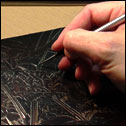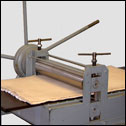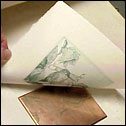The Italian term INTAGLIO refers to a number of printmaking techniques in which lines incised below the surface of a metal plate carry the ink. These techniques include ETCHING which requires the use of acid to incise the line, and DRYPOINT where the line is cut directly with a sharp tool. I generally prefer etching in its various forms to create my prints.
THE BASICS…
To make a line ETCHING, a thin waxy protective coating called a “ground” is applied to a clean copper or zinc plate. The image is drawn through the ground with an etching needle or other pointed instrument exposing the metal. The plate is then immersed in an acid bath which “bites” into the metal where the ground was scratched away creating a depression. The ground is removed with a solvent and ink is spread on the plate. The excess ink is removed from the surface by buffing the plate with a “tarlton” (muslin) and then with the heel of the hand. The ink remains in the incised lines. The inked plate is placed on the bed of the press and covered with damp paper and the “blankets & felts” of the press. As it is “pulled” through the press, the plate passes between two steel rollers and the pressure of the rollers forces the damp paper into the recessed lines where it picks up the ink. The line of ink has dimension and can be felt on top of the paper when dry.

The image is drawn through the protective ground covering the plate.

After the exposed areas of the plate are etched with acid, ink is applied.

The inked plate is covered with damp paper & blankets & pulled through the press.

The pressure of the press transfers the image to the paper.
AQUATINT is a tonal method of etching which can be used alone or in addition to line etching. To make an aquatint, powdered rosin is dusted on the plate and then melted and fused to the plate by heating it. The plate is then briefly submerged in acid. The tiny dots of rosin will resist the acid and the areas around them will be etched. Lighter areas are progressively blocked out with applications of ground, while darker areas are exposed repeatedly until the desired range of tones has been achieved.
DRYPOINT is an intaglio method where the image is scratched directly into the surface of a zinc or copper plate with an etching needle or other sharp instrument. The jagged metal that is raised along the scratch is called the “burr.” The line is not as deep as an etched line and most of the ink clings to the burr. This prints as a rich yet somewhat fuzzier, softer line than an acid etched line. The pressure of the press causes the burr to gradually flatten out, therefore the editions are generally fewer in number.
MONOPRINT is an image created using a combination of permanent incised lines and freeform painting or selective wiping of the ink on the surface of the plate. The image varies each time it is printed, so it is considered a single, unique print.
MONOTYPES are a combination of painting and printmaking techniques. The image is developed using paint or ink on an unaltered surface and transferred to another surface, usually paper, by hand rubbing or with a press. Since the image is not fixed on the plate it is a one of a kind print.
